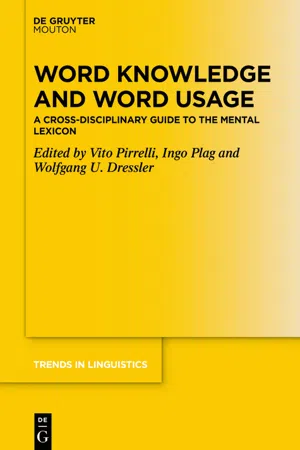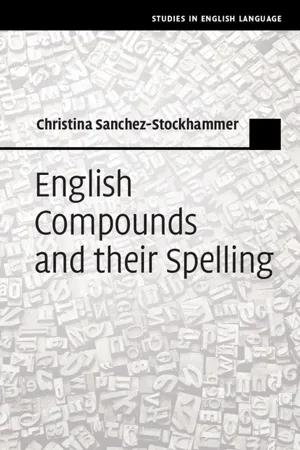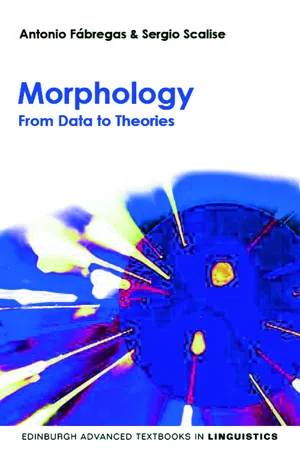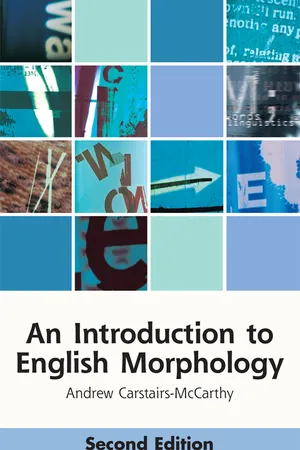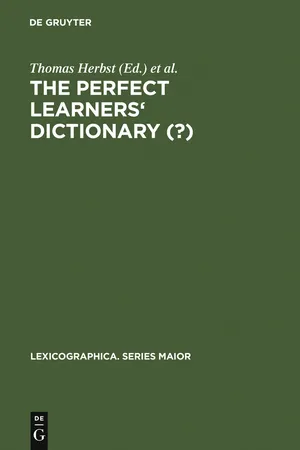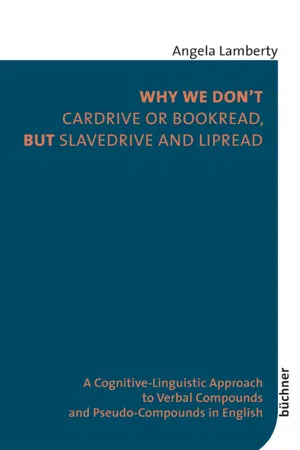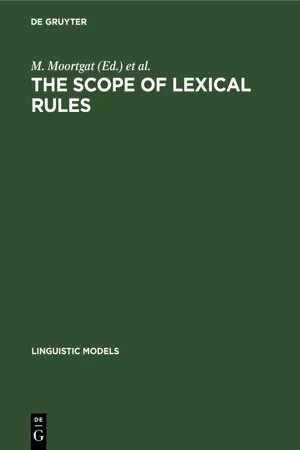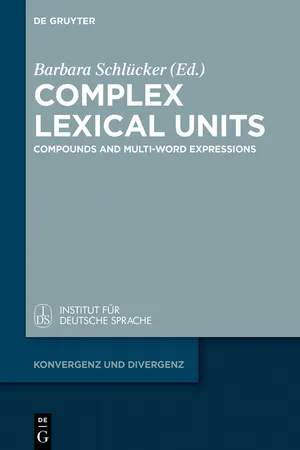Languages & Linguistics
Compound Words
Compound words are formed by combining two or more words to create a new word with a distinct meaning. These words can be formed through various processes, such as combining two nouns (e.g., "toothbrush"), a noun and an adjective (e.g., "blackboard"), or a verb and a noun (e.g., "breakfast"). Compound words are prevalent in many languages and play a significant role in vocabulary expansion.
Written by Perlego with AI-assistance
Related key terms
1 of 5
10 Key excerpts on "Compound Words"
- eBook - PDF
Word Knowledge and Word Usage
A Cross-Disciplinary Guide to the Mental Lexicon
- Vito Pirrelli, Ingo Plag, Wolfgang U. Dressler, Vito Pirrelli, Ingo Plag, Wolfgang U. Dressler(Authors)
- 2020(Publication Date)
- De Gruyter Mouton(Publisher)
Gary Libben, Christina L. Gagné and Wolfgang U. Dressler The representation and processing of compounds words Abstract: Compound Words may be the language structures that are most funda-mental to human linguistic ability and most revealing of its dynamics. We review evidence to date on the representation and processing of Compound Words in the mind and highlight the implications that they have for the broader understanding of language functioning and lexical knowledge. Our examination of the nature of compounds focuses on their deceptive simplicity as well as their dual nature as words and lexical combinations. Compound processing appears to be advantaged when compounds belong to morphologically productive families and when they are both formally and semantically transparent. We also claim that current find-ings offer converging evidence that compound word processing is characterized by both whole word and constituent activation for compound types. Keywords: morphology, compounding, Compound Words, processing, psycho-linguistics, semantic transparency, compositionality, productivity 1 Introduction and overview Perhaps the most fascinating thing about language is that, through apparently simple acts of creating and combining words, human beings are able to develop the extraordinary richness and suppleness of communication that characterizes our species. In this chapter, we focus on Compound Words, which may consti-tute the language structure that is most fundamental to the human ability to create new language entities from existing ones. In this way, compounding of-fers special insight into the representation and processing of multimorphemic words across languages. Compounds are prevalent across languages, they often play an important role in the creation of new words within a language, and the major constituents of Compound Words are typically easily identified by native speakers. - eBook - PDF
- Christina Sanchez-Stockhammer(Author)
- 2018(Publication Date)
- Cambridge University Press(Publisher)
. . and functioning both grammatically and semanti- cally as a single word”. This implicit inclusion of grammatical constituents results in the following preliminary definition (cf. 2.6 for the final version): A compound is a complex lexeme which consists of at least two constituents occurring as free lexemes each and which contains no affixation on the highest structural level. However, this definition still leaves room for interpretation. Compounds need to be set apart both from other lexemes (most of which are regarded as the result of word formation processes) and from phrases (which are regarded as the result of syntactic processes), although there seems to be a tendency to regard these two domains as ever more gradient (e.g. Erman and Warren 2000: 53). The following sections discuss the criteria which are commonly used in the literature to distinguish compounds from other linguistic entities. Furthermore, they give an overview of the types of compound recognised in the present study based on length, word forma- tion type, part of speech and spelling. 2.1 Compounds versus Phrases It is the distinction between compounds and phrases that seems to repre- sent the most important difficulty – at least considering the vast amount of literature devoted to the topic. According to Donalies (2003: 79), the comparison may be complicated by differences between the categories, with words being formed according to word formation rules and phrases being formed according to syntactic rules. However, the general 1 The term lexeme is understood here in the sense of “the fundamental unit . . . of the lexicon of the language” (Matthews 1974: 22) and following Cruse (1986: 80), who defines the lexeme as “a family of lexical units” – by which he understands “the union of a single sense with a lexical form”, the latter of which is an abstraction from all possible inflected forms. - eBook - PDF
Morphology
From Data to Theories
- Antonio Fábregas, Sergio Scalise(Authors)
- 2012(Publication Date)
- Edinburgh University Press(Publisher)
111 6 COMPOUNDING AND OTHER WORD- FORMATION PROCESSES 6.1 PROPERTIES OF COMPOUNDS Compounding is a word-formation process that combines two or more roots inside the same word. The relation which is established between the elements combined inside a compound is generally not very different from the relations seen between phrases in syntax: modification, coordination or subordination (as we will see in §6.2.). Additionally, the distinction between phrases and words is not as sharp in com-pounding as it is in inflection or derivation (see §6.3). All of these characteristics invite a view of compounding as a morphological operation which is close to syntax. Some authors (Jackendoff 2007) have argued, even, that compounding might reflect some kind of primitive syntax which is able to create a more complex structure by combin-ing units which are morphologically independent, as in the cases in (1), without intro-ducing functional material, such as determiners ( the , a ) or prepositions ( of ). (1) a. police dog b. apple pie c. razor sharp d. pick pocket Nature of the units combined Given the fact that police , dog , apple , and pie are not morphologically bound forms, compounding – judging from (1) – does not seem too far away from a protosyntax that assembles words into more complex structures. However, this conclusion is not uncontroversial, and if we examine morphologically richer languages, we see that compounds do not always contain syntactically independent objects. The cases in (1) are called root compounds, because the objects combined within them are identical to morphological roots. In English, the root and the word can be the same, but in a language with stems (§2.4.1) and rich inflection, like Spanish, a root compound does not involve the combination of syntactically free objects. - eBook - PDF
An Introduction to English Morphology
Words and Their Structure (2nd edition)
- Andrew Carstairs-McCarthy(Author)
- 2017(Publication Date)
- EUP(Publisher)
We have also seen that at least one syntactic relationship can be expressed within compounds just as well as within sentences, namely the verb–object relationship (or perhaps one should say the action–goal relationship), as in hair restorer. One might ask, then, why English, or any language, needs both com- pound word-structure and clause-structure side by side: could not just one do the work performed in actual English by both? That is an impor- tant question, but unfortunately one for which there is no generally agreed answer. Further discussion of it is therefore a task for research papers, rather than for an introductory textbook such as this. Technical terms acronym – blend incorporating only the initial letters of its compo- nents, e.g. NATO for North Atlantic Treaty Organization. (Abbreviations such as USA or BBC, in which the name of each letter is pronounced in turn, are not acronyms.) argument – noun phrase or prepositional phrase that is a required or expected concomitant of a verb. For example, sleep normally has one Compound Words, BLENDS AND PHRASAL WORDS 75 argument (The boy slept) while kick has two (The boy kicked the ball) and introduce has three (The boy introduced his sister to the visitors). blend – kind of compound in which at least one of the components is reproduced only partially, e.g. smog, combining elements of smoke and fog. combining form – bound morpheme, more root-like than affix-like, usually of Greek or Latin origin, that occurs only in compounds, usually with other combining forms. Examples are poly- and -gamy in polygamy. compound – word containing more than one root (or combining form). endocentric (of a compound or derived word) – possessing a head. See also exocentric. exocentric (of a compound or derived word) – lacking a head. For example, the noun sell-out is exocentric because it contains no com- ponent that determines its word class (sell being a verb and out being an adverb). - eBook - PDF
- Thomas Herbst, Kerstin Popp, Thomas Herbst, Kerstin Popp(Authors)
- 2011(Publication Date)
- De Gruyter(Publisher)
Henri Bejoint Compound nouns in learners' dictionaries 1 Introduction Compounds are not a popular subject for research in lexicography - unlike idioms, or phraseology in general. 1 Yet, they are important, for at least two reasons. The first is that they are in very large numbers in many languages, including English: they make up an important proportion of all lexical creations, as exhibited in English dictionaries of new words (Ayto 1996). The second and main reason is that they are, to some extent, language in the making. They exemplify what is sometimes called onomasiology in the creation of lexis, and as such, they are a special challenge for the lexicographer. The present paper will examine compound nouns - probably the largest category (Bauer 1983: 202) - rather than adjectives or verbs. After a brief look at the definition of compound nouns, I will proceed to discuss the peculiarities of their meaning, and finally examine some aspects of their definitions in the Cambridge International Dictionary of English (1995 - CIDE), the Collins COBUILD English Dictionary, second edition (1995 -COBUILD2), the Longman Dictionary of Contemporary English, third edition (1995 -LDOCE3), and the Oxford Advanced Learner's Dictionary, fifth edition (1995 - OALD5). Most examples will therefore be in English, with some additional illustrations in French. 2 Of compounds in general and compound nouns in particular 2.1 Definitions A compound is a lexical unit composed of at least two autonomous elements (i.e. words). Several criteria for distinguishing compound nouns have been mentioned (see Tournier 1988: 63f.): • graphic cohesion. This is difficult to apply, particularly in English, because of the variations in spelling: an English compound noun like paper clip can have the forms I would like to thank Rosamund Moon for helpful comments on a draft version of this paper (her remarks are noted RM), and Philippe Thoiron for generous discussions on many of the issues. - eBook - PDF
Why We Don't Cardrive or Bookread, but Slavedrive and Lipread
A Cognitive-Linguistic Approach to Verbal Compounds and Pseudo-Compounds in English
- Angela Lamberty(Author)
- 2014(Publication Date)
- Büchner-Verlag(Publisher)
3.1 The birth of new words The vocabulary of the English language is not a static system, but subject to constant change due to the addition of new lexemes and the loss of obsolete words. Compounding of two free lexical mor-phemes is only one possibility among a variety of word-formation patterns the English language has at its disposal (Schmid 2011b, 69– 70). Irrespective of the nature of the word-formation pattern underlying it, a novel lexeme necessarily starts out as an ad-hoc formation when it is first being used by a speaker or writer. Following this first occurrence, it has to pass through various stages before it finally becomes a fully established lexeme. These stages are 1. creation, 2. consolidation, and 3. establishment (Schmid 2005, 72– 73; also Schmid 2011b, 70–71). Depending on whether a structural, 74 T OWARDS A C OGNITIVE -L INGUISTIC A PPROACH socio-pragmatic or cognitive perspective is adopted, the processes involved can be called ‘Lexicalization’, ‘Institutionalization’ , or ‘Hypostatization’ (Schmid 2005, 73; Schmid 2008, 3). Under these headings, the following three subchapters will provide some further information concerning the establishment of new lexemes. In this context, the approach put forward by Schmid (2005; 2011b) will be adopted. 3.1.1 Lexicalization In English, compounding is one of the most frequent word-formation patterns that satisfies the need for new words. From a structural point of view, a word can be said to be lexicalized, i.e. inte-grated into the lexicon, once it has passed through the processes of creation and consolidation and reached the stage of being fully estab-lished (Schmid 2005, 79). In a more general sense, lexicalization is regarded as a gradual process and—at least according to Lipka— necessarily dependent on the frequency of usage of the respective lexeme (Lipka 1981, 120). - eBook - PDF
- M. Moortgat, H. v. d. Hulst, T. Hoekstra, M. Moortgat, H. v. d. Hulst, T. Hoekstra(Authors)
- 2020(Publication Date)
- De Gruyter Mouton(Publisher)
A similar demonstration of the autonomy of word syntax can be made on the basis of affixation. The reader is referred to Selkirk (forthcoming), where English affixation is examined, and it is shown that the general theoretical framework proposed here permits an illuminating characteri-zation of the significant properties of affixes and the structures containing them. Section 2: Compounding 2.1. Compounds in English are constituents of morphological structure which are made up of two elements belonging to the categories noun, adjective, verb, or preposition; the compound itself may belong to the category noun, adjective, or verb. (See Marchand (1969), Adams (1973), and Jespersen (MEG) for excellent de-scriptions of compounding in English.) The vast majority of compound types in English contain as the righthand member a constituent which is of the same cate-gory as the compound itself. For the moment we will limit our attention to these. ENGLISH COMPOUNDING 239 As the examples in (10) - (12) show, a compound noun may be constituted of a noun, adjective, preposition, or verb on the left and a noun on the right, a compound adjective may consist of first a noun, adjective, or preposition and then an adjective, and a compound verb may consist of a preposition and then a verb: (10) Houns a. N N apron string sun shine mill wheel hub cap living room fighter bomber tongue lashing teacher training school teacher bull's eye b. A N high school small pox sharp shooter well wisher c. p N overdose underdog out building up rising on looker after thought up town in land d. V N swear word whet stone scrub woman rattle snake (11) Adjectives a. N A head strong honey sweet skin deep nation wide sea faring mind boggling earth bound heart broken b. A A icy cold white hot worldly wise easy going hard working high born wide spread far fetched c. P A overwide overabundant underripe ingrown underprivileged abovementioned d. - eBook - PDF
- Claudia Maienborn, Klaus Heusinger, Paul Portner, Claudia Maienborn, Klaus Heusinger, Paul Portner(Authors)
- 2019(Publication Date)
- De Gruyter Mouton(Publisher)
https://doi.org/10.1515/9783110589849-004 Susan Olsen 4 Semantics of compounds 1 Introduction 103 2 Early treatments of compound meaning 105 3 Semantic approaches to compound meaning 110 4 Cognitive psychological approaches to compound meaning 116 5 Origin of compounds in a protolanguage? 121 6 Compounds in the lexical system of grammar 123 7 Left-headed compounds 128 8 Constraints on the productive compounding process 134 9 Conclusion 139 10 References 139 Abstract: Compounds, at least on the surface, seem to exemplify a baffling array of different types and patterns. This contribution concentrates on the characteriza-tion of the regular, productive, determinative pattern of noun-noun combinations in its search for a theoretical analysis able to unite the different constructions in a coherent way into a single pattern of interpretation that is to be expected of such a simple juxtaposition of lexemes. It proceeds chronologically through several different analytical perspectives to arrive at a simple analysis in terms of a template that conjoins two predicates mediated by an open conceptual inference. The success of the compound template provides the basis for the consideration of such further questions as the different function of compounds vis-à-vis seemingly equivalent syntactic phrases (computer screen—screen of a computer, table top— top of a table). It then broaches the questions of how less regular patterns can be subsumed under the general analysis and what restrictions apply to the inference process of a conceptual relation underlying compound meaning. 1 Introduction Compounding is a process of word formation in which two lexemes are combined to form a complex lexeme, cf. trumpet blast . It is a highly productive process in many languages which results in a binary grouping of constituents in which one Susan Olsen, Berlin, Germany 104 Susan Olsen of the constituents functions as the head. For example, smart phone is a noun because phone , the head, is a noun. - eBook - PDF
Poetic Compounds
The Principles of Poetic Language in Modern English Moetry
- Jean Boase-Beier(Author)
- 2010(Publication Date)
- De Gruyter(Publisher)
In this assumption we follow Selkirk (1982: 10). For a discussion of the notions lexicalised and ad hoc, see Boase-Beier et al. (1985: 6 f ) . 38 3.2. Possible Compounds Any explanatory study o£ the word-formation of a language is concerned with the notion possible word. That is, it attempts to show which products of word-formation are generated by the grammar and which are not, or, to put it differently, which words are acceptable and which are not. In connection with the topic of study here, there will be a further concern, namely: what is the difference between possible complex words of SL and possible complex words of PL? The brief account of the grammar of compounding in English in this Chapter (see 3.3) attempts to answer the question as to what is a possible compound word of SL. In Chapter 4 we shall look at compounds which, according to the grammar as sketched here, are not possible, but which occur in the poems under discussion. We shall argue that, if the grammar does not generate them, they must come from somewhere else. And we shall try to establish where exactly they do come from, that is, which additional poetic principles are required and in what way these interact with the grammar to produce the forms in question. Recall that in Chapter 1 we described poetic language, in Grinder & Elgin's words, as the language of a poetic text left over when we have excluded gibberish on the one hand and ordinary discourse on the other (1973: 169). It is thus clear that we are concerned with a three-fold division of language, namely into: (i) compounds generated by the grammar and hence possible both in SL and PL, i.e. - eBook - ePub
Complex Lexical Units
Compounds and Multi-Word Expressions
- Barbara Schlücker(Author)
- 2019(Publication Date)
- De Gruyter(Publisher)
In this chapter, we sought to present an introductory overview of compound and MWE formation in a sample of European languages. We started with some general considerations about the notion of complex lexical unit, the lexicon, and the lexicon-syntax interface, and provided some preliminary criteria for the distinction between compounds and MWEs. In the second part of the chapter, we reviewed the language-specific properties of compounds and MWEs in West Germanic, North Germanic, Romance, Greek, Slavic, and Finno-Ugric languages, comparing them to German. Central questions that were discussed for each language family included the formal distinction between compounds and MWEs (in particular prosodic, morphological, and syntactic properties), the relationship between compounding and MWE formation as well as the conclusions concerning the theory of grammar and the lexicon following from these observations. One major finding is that while there are great similarities as well as differences regarding compound and MWE formation in the languages of Europe, a cross-linguistically valid definition of compounds and MWEs is hard to establish, because the languages differ greatly with respect to both the compound criteria that can be relevantly applied to them, and the relevant types of compound and MWE patterns and their degree of productivity. The various chapters of this volume provide in-depth analyses of the situation in the respective languages and language families, also discussing in more detail the relevant implications for the theory of the lexicon-grammar interface.References
Anderson, Stephen R. (1982): Where’s morphology? In: Linguistic Inquiry 13. 571–612. Anward, Jan/Linell, Per (1976): Om lexikaliserade fraser i svenskan. In: Nysvenska studier 55/56. 76–119. Arnaud, Pierre J. L. (2015): Noun-noun compounds in French. In: Müller, Peter O. et al. (eds.). 673–687. Bağrıaçık, Metin/Ralli, Angela (2015): Phrasal vs. morphological compounds: Insights from Modern Greek and Turkish. In: STUF – Language Typology and Universals 68, 3. 323–357.Bandle, Oscar et al. (eds.) (2005): The Nordic Languages. An International Handbook of the History of the North Germanic Languages. Vol. 2. (= Handbooks of Linguistics and Communication Science (HSK) 22.2). Berlin/New York: De Gruyter.
Index pages curate the most relevant extracts from our library of academic textbooks. They’ve been created using an in-house natural language model (NLM), each adding context and meaning to key research topics.
